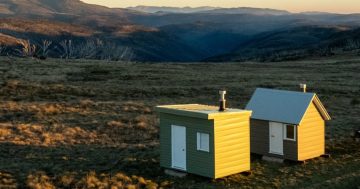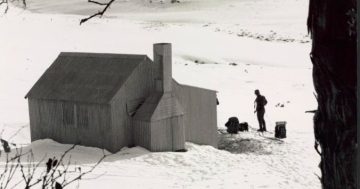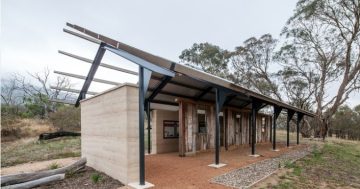
Sawyers Hut – a popular rest stop for motorists driving between Tumut and Cooma – is now officially open thanks to a rebuild involving a number of volunteer groups including the Kosciuszko Huts Association. Image: Kosciuszko Huts Association.
Anyone familiar with the route from Tumut to Cooma will know the historic rest house at Sawyers Hill – a popular rest stop for motorists – has seen more than its fair share of fires.
But the solitary old board and batten hut is also proving to be something of a monument to the tenacity and resolve of those people who absolutely refuse to see it, and other remnant mountain buildings, disappear from the high country.
Sawyers Hut once formed part of a larger building originally built in the early 1900s as a staging post for coaches on their way to Rules Point.
Its purpose, early last century, was to shelter coach travellers who used the old Kiandra Road as they journeyed to and from the Rules Point Hotel, the centre of social life in the high country area for many years.
Updated in 1960, Sawyers Hut was then badly damaged in the 2003 Australian Alps bushfires which razed some 1.73 million hectares across Victoria, NSW and the ACT.
Rebuilt in 2008-09, it was then destroyed – bar the chimney – in the 2019-2020 Black Summer bushfires.
But it’s back and has recently reopened in grand style with a ribbon cutting ceremony and large crowd thanks to the efforts and determination of a small group dedicated to the preservation of the conservation of huts and homesteads in the Australian Alps national parks and reserves of NSW and the ACT.
The Kosciuszko Huts Association (KHA) doesn’t just volunteer labour assistance to both the NSW National Parks and Wildlife Service (NPWS) and ACT Parks and Conservation Service (PCS); their raison d’etre is maintaining traditional skills and knowledge, researching and documenting history, raising public awareness, and advocating to governments for hut protection and conservation.
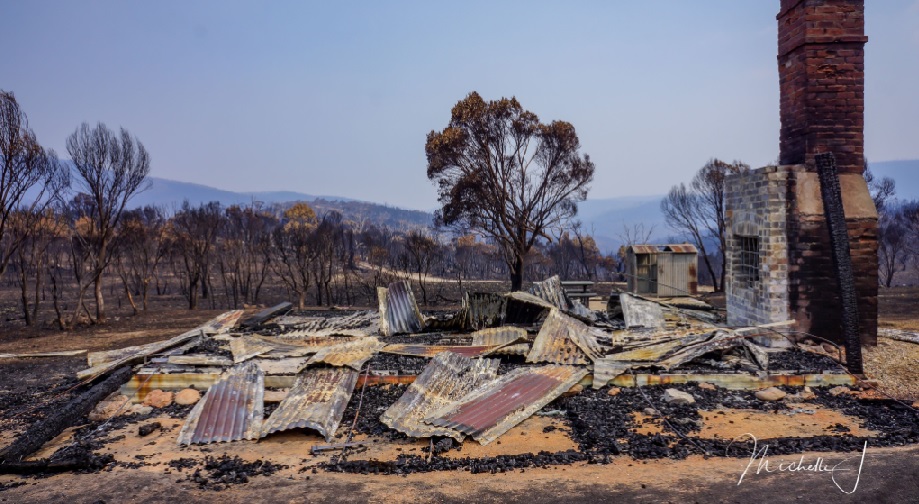
With just a chimney remaining, Sawyers Hut was destroyed in the 2019-2020 Black Summer bushfires. But this wasn’t the first time the hut had to be rebuilt due to fire. Image: Michelle J Photography.
Operating in NSW since 1971 and the ACT since 1990, it is believed to be the only volunteer body that actually undertakes the physical reconstruction works – using skilled trades – rather than relying on fundraising for commercial entities to undertake the work.
NSW NPWS ranger, Megan Bowden, with carpenter Roger Rosenboom and field officer Peter Dow are leading the rebuilds of these important heritage assets.
So, it will come as no surprise the old but new building that Sawyers Hut is today – with the exception of a concrete floor – is true to its original design, erected using vertical wooden slabs, iron roof with a fireplace and chimney constructed of stone and brick.
Fire-resistant strategies including treating timbers with fire retardant and wrapping window sills with iron, were used in the construction of the new hut.
But it wasn’t just Sawyers Hut that reopened recently with a flourish.
Nearby Delanys Hut is the second of 10 huts on a long list of post-bushfire rebuilds in the Snowy Mountains to reopen its door.
Like Sawyers Hut, Delanys was also destroyed in the 2003 fires, rebuilt in 2007 and again destroyed in the January 2020 bushfires.
Built in 1910 as a cattleman’s hut by the high country Delaney family of Buckenderry Station, the hut was characterised by weatherboard and slab walls, part dirt floor and ironclad chimney.
It was also here the mailman Tom Bolton – employed to undertake the mail run from Adaminaby to the old gold mining town of Kiandra – was a frequent visitor.
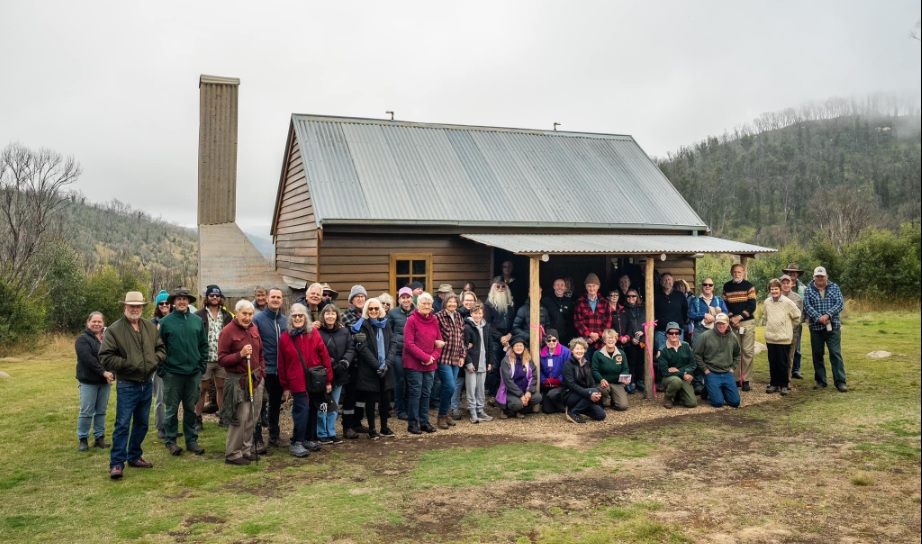
The grand opening of the popular Delanys Hut – an old cattleman’s hut – took place in early April. Image: Toms Outdoors.
The mail was firstly taken by sulky to Delanys Hut. There the mailman transferred to horseback for the short leg up to Sawyers Hut. The final leg of the run was on snowshoes.
According to recollections in Klaus Hueneke’s book People of the Australian High Country, Bolton used trig sites above the trees if the snow got too deep, to determine where he was going.
Delanys Hut was built in 1910 by James (Jim) Thomas Delany for grazing his cattle from Buckenderra Station. James Thomas was the son of James Delany of Buckenderry Station (its earlier name).
And while Vickerys Hut has been completed, the call has gone out for flattened or whole kerosene/oil cans for the rebuild of Vickerys Chaff Shed.
The original Vickerys Hut was built in 1945 by the Vickery family of Tumut on their grazing lease located on a small grassy flat along the Jounama Creek.
The shed illustrates the skills of the builders in their use of existing materials including the flattened kerosene tins which line the exterior walls of the shed.
People wishing to donate old cans for that construction are asked to email Megan Bowden.
Megan is also on the lookout for artefacts for the Kiandra Heritage Precinct rebuild – particularly for the Kiandra Courthouse – the birthplace of skiing in Australia.
There are over 200 historic huts, buildings and structures across the National Heritage listed Australian Alps National Parks and Reserves of the ACT, NSW and Victoria.
Many of the huts are associated with past periods of pastoralism while others are associated with mining, surveying, logging and milling, hydroelectric development, scientific research, conservation and park management or recreation such as skiing, bushwalking or fishing.







